SpringMVC源码深入解析
通过前面 SpringAOP源码深度解析 , SpringIOC源码深度解析 加上本文的SpringMVC的源码阅读,我从中收获很多,学习了各种设计模式,各种抽象思想,以及各种底层原理,比如动态代理,反射等等,虽然前前前后后大概花了一个多月,但是我不后悔,并不觉得是浪费时间。
本文比较长,我花了三天的时间完成本文,但是还是水平有限,不可能面面俱到,当中也可能会有错的,还请读者指出,一起交流一起进步。
本文采用的源码版本是5.2.x,同样,为了能收获更多,还请读者打开Spring的源码工程进行跟进。
基础知识
Servlet的基础知识
为什么要先了解Servlet的知识呢,因为后面你会看到我们所熟悉的SpringMVC其实也是一个Servlet,只是它封装了很多的东西并和Spring进行了整合,后面我们进行的源码分析就是围绕着Servlet的生命周期进行的,所以有必要了解一下Servlet相关的知识。
Servlet概念
全称 Java Servlet ,是用Java编写的服务器端程序。其主要功能在于 交互式地浏览和修改数据,生成动态Web内容。Servlet运行于支持 Java应用的服务器中。从原理上讲,Servlet可以响应任何类型的请求, 但绝大多数情况下Servlet只用来扩展基于HTTP协议的Web服务器。
Servlet的工作原理
下面通过一张时序图来理解Servlet的工作流程
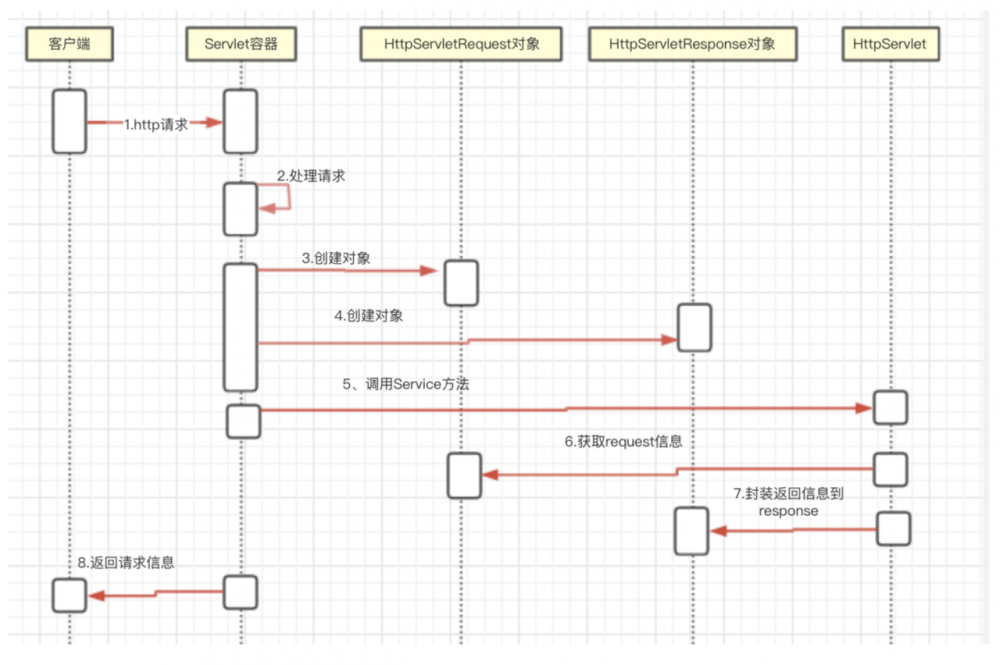
从上面的时序图总结如下:
- 首先客户端请求接入
- Servlet容器,比如Tomcat处理请求
- Tomcat 创建HttpServletRequest对象,将请求的信息封装到这个对象中。
- Tomcat 创建HttpServletResponse对象, 此时是一个空的对象等待请求返回并填充
- Tomcat 调用service方法,最终传递到子类HttpServlet中
- HttpServlet从request中获取请求信息,处理完毕后将返回值信息封装到HttpServletResponse对象
- Tomcat容器返回处理后的信息
Servlet生命周期
打开Servlet源码发现Servlet接口有几个方法:
- init()方法Tomcat创建Servlet时会调用
- 每次有请求来时Tomcat都会调用service()方法
- 请求结束时Tomcat会调用destroy()方法
public interface Servlet {
//Servlet创建时会调用init方法进行初始化
void init(ServletConfig var1) throws ServletException;
ServletConfig getServletConfig();
// 每次有新的请求来时都会调用
void service(ServletRequest var1, ServletResponse var2) throws ServletException, IOException;
String getServletInfo();
// 请求结束时调用
void destroy();
}
复制代码
一个Servlet例子
写一个AddUserServlet类继承自HttpServlet(为什么要继承这个类后面有说明)
public class AddUserServlet extends HttpServlet {
private static final long serialVersionUID = 1L;
protected void doGet(HttpServletRequest request, HttpServletResponse response)
throws ServletException, IOException {
response.setContentType("text/plain;charset=utf8");
response.getWriter().write("添加成功");
}
protected void doPost(HttpServletRequest request, HttpServletResponse response)
throws ServletException, IOException {
doGet(request, response);
}
}
复制代码
webapp/WEB-INF下新建web.xml
<?xml version="1.0" encoding="UTF-8"?>
<web-app xmlns:xsi="http://www.w3.org/2001/XMLSchema-instance"
xmlns="http://java.sun.com/xml/ns/javaee"
xsi:schemaLocation="http://java.sun.com/xml/ns/javaee http://java.sun.com/xml/ns/javaee/web-app_2_5.xsd"
version="2.5">
<servlet>
<description></description>
<display-name>AddUserServlet</display-name>
<servlet-name>AddUserServlet</servlet-name>
<servlet-class>com.sjc.springmvc.servlet.AddUserServlet</servlet-class>
</servlet>
<servlet-mapping>
<servlet-name>AddUserServlet</servlet-name>
<url-pattern>/AddUserServlet</url-pattern>
</servlet-mapping>
</web-app>
复制代码
将程序部署到Tomcat就可以访问了(具体不会的请读者查相关资料)
有同学可能会产生疑惑:我都没有看到main方法,怎么就可以访问了呢?
回答如下:
Servlet实际上是tomcat容器生成的,调用init方法可以初始化。他有别于 普通java的执行过程,普通java需要main方法;但是web项目由于是服务器控 制的创建和销毁,所以servlet的访问也需要tomcat来控制。通过tomcat访问 servlet的机制是通过使用http协议的URL来访问,所以servlet的配置完想要访 问,必须通过URL来访问,所以没有main方法。
应用系统三层架构
表现层
也就是我们常说的web层
- 它负责接收客户端请求,向客户端响应结果,通常客户端使用http协议请求web层,web需要接收http请求,完成http响应
- 表现层包括展示层和控制层:控制层负责接收请求,展示层负责结果的展示
- 表现层依赖业务层,接收到客户端请求一般会调用业务层进行业务处理,并将处理结果响应给客户端
- 表现层的设计一般都使用MVC模型
业务层
- 也就是我们常说的service层。
- 它负责业务逻辑处理,和我们开发项目的需求息息相关。web层依赖业务层,但是业务层不依赖web层。
- 业务层在业务处理时可能会依赖持久层,如果要对数据持久化需要保证事务一致性。
持久层
- 也就是我们常说的dao层。
- 负责数据持久化,包括数据层即数据库和数据库访问层,数据库是对数据进行持久化的载体,数据访问层是业务层和持久层交互的接口,业务层需要通过数据访问层将数据持久化到数据库中
- 通俗的讲,持久层就是和数据库交互,对数据库表进行增删改的。
MVC设计模式
MVC是模型(model)、视图(view)、控制器(controller)的缩写,是一种用于设计编写web应用程序表现层的模式
MVC设计模式的三大角色:
-
Model(模型):
模型包含业务模型和数据模型,数据模型用于封装数据,业务模型用于处理业务。
-
View(视图): 通常指的是我们的jsp或者html。作用一般就是展示数据的。
通常视图是依据数据模型创建的。
-
Controller(控制器):
是应用程序中处理用户交互的部分。作用一般就是处理程序逻辑的。
SpringMVC的流程分析
理解SpringMVC,只要你理解了下面介绍的六大组件基本上就可以了。后面的源码分析我们也是围绕着这六大组件来的。
SpringMVC流程如下图所示:
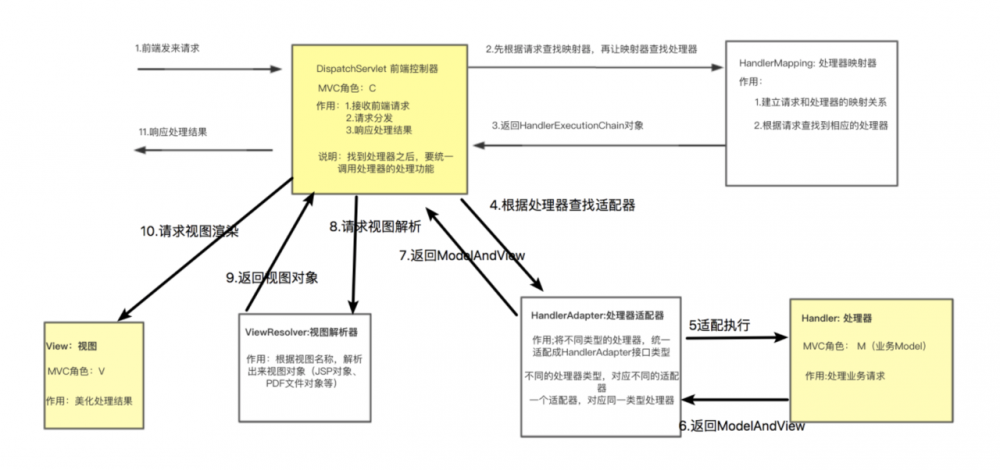
总结如下:
-
DispatcherServlet: 前端控制器
用户请求到达前端控制器,它就相当于MVC中的C,DispatcherServlet是整个流程控制的中心,由它调用其他组件处理用户的请求,DispatcherServlet的存在降低了组件之间的耦合性
-
Handler:处理器
Handler是继DispatcherServlet前端控制器的后端控制器,在DispatcherServlet的控制下Handler对具体的用户请求进行处理
由于Handler涉及到具体的用户业务请求,所以一般情况下需要程序员根据业务需求开发Handler
常用的有比如Controller,HttpRequestHandler,Servlet、@RequestMapping等等,所以说处理器其实是一个宽泛的概念
-
View:视图
SpringMVC框架提供了很多的view视图类型的支持,包括:jstlview、freemarkerview、pdfview等。我们最常见的视图就是jsp。 当然,现在很少用jsp了,现在大部分都是前后端分离了,所以后面源码分析我们会忽略视图
-
HandlerMapping: 处理器映射器
HandlerMapping负责根据用户请求找到Handler即处理器,SpringMVC提供了不同的映射器实现不同的映射方式比如:配置文件方式(BeanNameUrlHandlerMapping)、实现接口方式和注解方式(RequestMappingHandlerMapping)等。
-
HandlerAdapter: 处理适配器
SpringMVC通过适配器模式,将不关联的 DispatcherServlet 和Handler进行关联,通过适配器调用具体的Handler实现。
-
View Resolver:视图解析器
View Resolver负责将处理结果生成view视图,View Resolver首先根据逻辑视图解析成物理视图名即具体的页面地址,再生成view视图对象,最后对view进行渲染,将处理结果通过页面展示给用户。
Spring源码解析
初始化init()
我们上面说过,分析源码的时候从Servlet入手,我们看它的初始化init()。首先看下类结构图,我们发现DispatcherServlet这个核心组件就是一个Servlet,回到开头我们说的SpringMVC其实也是一个Servlet,只是做的事情比较多而已。
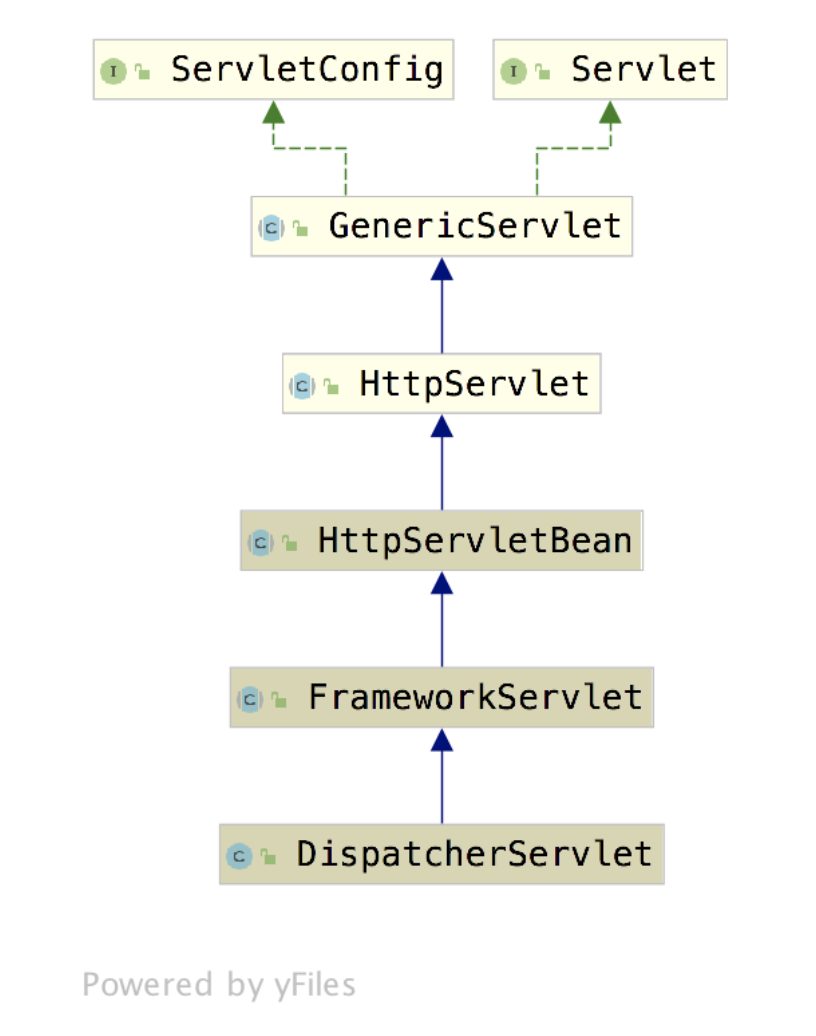
我们顺着这个类关系图,找到了FrameworkServlet#initServletBean
这里初始化了spring容器WebApplicationContext
@Override
protected final void initServletBean() throws ServletException {
//...省略若干代码
// 初始化web环境中的spring容器WebApplicationContext
this.webApplicationContext = initWebApplicationContext();
initFrameworkServlet();
//...省略若干代码
}
复制代码
我们进入到:FrameworkServlet#initWebApplicationContext
我们找到了两个分支
-
configureAndRefreshWebApplicationContext
这个分支会去初始化Spring容器,又会回到我们SpringIOC容器初始化的那十二步骤,相关的可以阅读我之前分析的 深度解析SpringIOC
-
onRefresh
会刷新容器的策略,我们主要看这一分支
protected WebApplicationContext initWebApplicationContext() {
//...省略若干代码
// 初始化spring容器
configureAndRefreshWebApplicationContext(cwac);
// 刷新容器中的策略
onRefresh(wac);
//...省略若干代码
}
复制代码
我们根据onRefresh,发现最终会进入到DispatcherServlet#onRefresh
protected void onRefresh(ApplicationContext context) {
// 初始化策略容器
initStrategies(context);
}
复制代码
我们进入到DispatcherServlet#initStrategies
这里会初始各种解析器,比如我们比较关心的处理器映射器,处理器适配器,至于为啥要在这里做初始化呢? SpringMVC为了扩展性,使用策略模式,将这些映射器适配器交给了配置文件,这样如果要再新增一个处理器就不需要改代码了,符合“对修改关闭,对扩展开放”的设计原则,这里的初始化也是为了策略模式做准备 这个也是我们学习源码学习到的知识,以后可以运用到我们实际的项目中。
比如下面的xml配置文件:
initStrategies就是从SpringIOC容器中获取到这些Bean,然后放入Map中来进行初始化的。
<beans> <!-- Handler处理器类的配置 --> <!-- 通过bean标签,建立beanname和bean的映射关系 --> <bean name="/queryUser2" class="com.sjc.springmvc.handler.QueryUserHandler"></bean> <bean name="/addUser2" class="com.sjc.springmvc.handler.AddUserHandler"></bean> <!-- HandlerMapping配置 --> <bean class="com.sjc.springmvc.handlermapping.BeanNameUrlHandlerMapping" init-method="init"></bean> <!-- HandlerAdapter配置 --> <bean class="com.sjc.springmvc.handleradapter.HttpRequestHandlerAdapter"></bean> </beans> 复制代码
读者感兴趣的话可以当做为一个分支进行验证。
protected void initStrategies(ApplicationContext context) {
// 初始化多部件解析器
initMultipartResolver(context);
// 初始化国际化解析器
initLocaleResolver(context);
// 初始化主题解析器
initThemeResolver(context);
// 初始化处理器映射器
initHandlerMappings(context);
// 初始化处理器适配器
initHandlerAdapters(context);
// 初始化异常解析器
initHandlerExceptionResolvers(context);
initRequestToViewNameTranslator(context);
// 初始会视图解析器
initViewResolvers(context);
initFlashMapManager(context);
}
复制代码
RequestMappingHandlerMapping初始化
在介绍HandlerMapping找到Handler的过程前,我们先来看看,RequestMappingHandlerMapping的初始化过程发生了什么。我这里先给个结论:
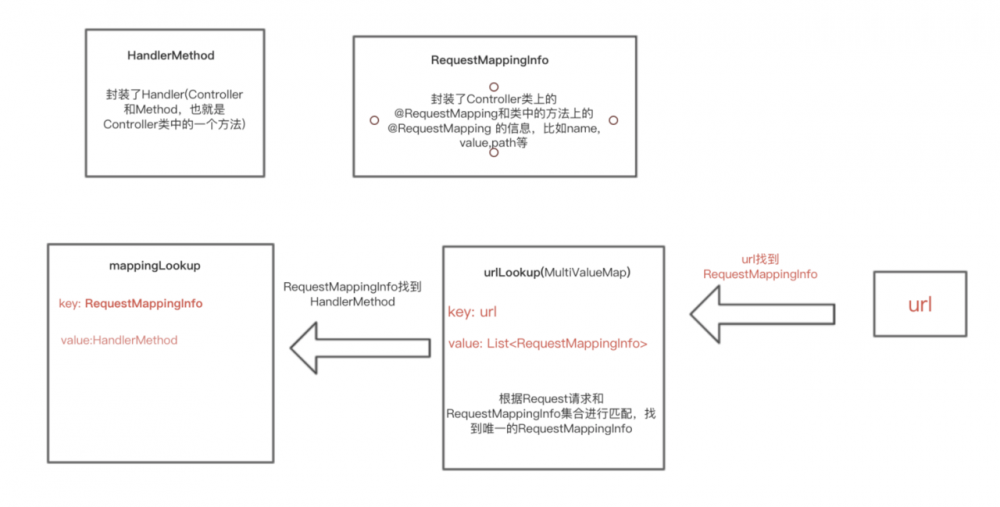
我们最终的目的就是通过url找到Handler(HandlerMethod)
我们进入到RequestMappingHandlerMapping,看到其中只有这样的方法:
@Override
public void afterPropertiesSet() {
this.config = new RequestMappingInfo.BuilderConfiguration();
this.config.setUrlPathHelper(getUrlPathHelper());
this.config.setPathMatcher(getPathMatcher());
this.config.setSuffixPatternMatch(this.useSuffixPatternMatch);
this.config.setTrailingSlashMatch(this.useTrailingSlashMatch);
this.config.setRegisteredSuffixPatternMatch(this.useRegisteredSuffixPatternMatch);
this.config.setContentNegotiationManager(getContentNegotiationManager());
// 调用父类AbstractHandlerMethodMapping的afterPropertiesSet方法
super.afterPropertiesSet();
}
复制代码
我们眼前一亮,它为我们提供了研究RequestMappingHandlerMapping初始化的入口,为什么这么说呢?我们知道SpringIOC提供了两种初始化方式: 第一种、就是在配置文件中中指定init-method方法,这种在我前面分析SpringIOC的文章可以看到**深入解析SpringIOC; **第二种、就是子类实现InitializingBean接口。这个接口有一个方法:
public interface InitializingBean {
void afterPropertiesSet() throws Exception;
}
复制代码
这样在初始化Bean的时候会调用afterPropertiesSet()方法。
这个流程我们在SpringIOC源码哪里可以看见呢?
我们进入AbstractAutowireCapableBeanFactory#invokeInitMethods
protected void invokeInitMethods(String beanName, final Object bean, @Nullable RootBeanDefinition mbd)
throws Throwable {
//判断该bean是否实现了实现了InitializingBean接口,如果实现了InitializingBean接口,则只掉调用bean的afterPropertiesSet方法
boolean isInitializingBean = (bean instanceof InitializingBean);
if (isInitializingBean && (mbd == null || !mbd.isExternallyManagedInitMethod("afterPropertiesSet"))) {
if (logger.isTraceEnabled()) {
logger.trace("Invoking afterPropertiesSet() on bean with name '" + beanName + "'");
}
if (System.getSecurityManager() != null) {
try {
AccessController.doPrivileged((PrivilegedExceptionAction<Object>) () -> {
//直接调用afterPropertiesSet
((InitializingBean) bean).afterPropertiesSet();
return null;
}, getAccessControlContext());
}
catch (PrivilegedActionException pae) {
throw pae.getException();
}
}
else {
//直接调用afterPropertiesSet
((InitializingBean) bean).afterPropertiesSet();
}
}
if (mbd != null && bean.getClass() != NullBean.class) {
String initMethodName = mbd.getInitMethodName();
//判断是否指定了init-method方法,如果指定了init-method方法,则再调用制定的init-method
if (StringUtils.hasLength(initMethodName) &&
!(isInitializingBean && "afterPropertiesSet".equals(initMethodName)) &&
!mbd.isExternallyManagedInitMethod(initMethodName)) {
//进一步查看该方法的源码,可以发现init-method方法中指定的方法是通过反射实现
invokeCustomInitMethod(beanName, bean, mbd);
}
}
}
复制代码
这两种方式哪一种先调用呢?
看源码我们发现实现了InitializingBean接口的类在Bean进行初始化的时候先被调用,然后调用init-method指定的方法;
哪一种方式的效率高呢?
当然是实现了InitializingBean接口的类方式,因为调用init-method指定的方法是通过反射实现的;但是通过映射文件方式消除了对spring的依赖
好了别跑远了,我们接着看RequestMappingHandlerMapping#afterPropertiesSet
里面会调用父类AbstractHandlerMethodMapping#afterPropertiesSet
public void afterPropertiesSet() {
// 初始化处理器方法对象
initHandlerMethods();
}
复制代码
接着进入:AbstractHandlerMethodMapping#initHandlerMethods
protected void initHandlerMethods() {
// 获取当前spring容器的所有bean的name,并遍历
for (String beanName : getCandidateBeanNames()) {
if (!beanName.startsWith(SCOPED_TARGET_NAME_PREFIX)) {
// 处理候选的Bean
processCandidateBean(beanName);
}
}
handlerMethodsInitialized(getHandlerMethods());
}
复制代码
我们关心的是processCandidateBean
进入:AbstractHandlerMethodMapping#processCandidateBean
这里面主要做三件事:
- 根据bean的名称,从当前spring容器中获取对应的Bean的Type
- 判断是否是Handler,也就是是否有@Controller或者@RequestMapping修饰类,如果有则是Handler对象
- 查找并封装HandlerMethod对象
protected void processCandidateBean(String beanName) {
Class<?> beanType = null;
try {
// 根据bean的名称,从当前spring容器中获取对应的Bean的Type
beanType = obtainApplicationContext().getType(beanName);
}
catch (Throwable ex) {
// An unresolvable bean type, probably from a lazy bean - let's ignore it.
if (logger.isTraceEnabled()) {
logger.trace("Could not resolve type for bean '" + beanName + "'", ex);
}
}
// 如果是Handler,则需要查找HandlerMethod(如果带有@Controller或者@RequestMapping则是Handler对象)
if (beanType != null && isHandler(beanType)) {
// 重要入口
// 从Controller或者RequestMapping注解的Bean中,找到所有的HandlerMethod对象,并进行存储
detectHandlerMethods(beanName);
}
}
复制代码
我们进入AbstractHandlerMethodMapping#detectHandlerMethods
这个方法比较复杂,主要用的lambda表达式太多,主要做这几件事:
- 将类上的@RequestMapping信息和Method上的Method信息封装成RequestMappingInfo对象
- 将Method方法和RequestMappingInfo对象建立映射,存储Map集合中
- 遍历methods,注册url和RequestMappingInfo映射关系,注册RequestMappingInfo和HandlerMethod的映射关系
protected void detectHandlerMethods(Object handler) {
// 获取处理器类型
Class<?> handlerType = (handler instanceof String ?
obtainApplicationContext().getType((String) handler) : handler.getClass());
if (handlerType != null) {
// 如果该类是通过cglib代理的代理类,则获取其父类类型,否则的话,直接返回该类
Class<?> userType = ClassUtils.getUserClass(handlerType);
// 存储Method方法和RequestMapping注解信息的映射关系(重点)
// 该映射关系会解析成我们需要的其他两个映射关系
// key是Controller类中的Method对象,value是RequestMappingInfo对象
Map<Method, T> methods = MethodIntrospector.selectMethods(userType,
(MethodIntrospector.MetadataLookup<T>) method -> { // 此处是设置回调函数
try {
// 获取bean上面和method上面的RequestMapping注解信息,封装到RequestMappingInfo对象中
return getMappingForMethod(method, userType);
}
catch (Throwable ex) {
throw new IllegalStateException("Invalid mapping on handler class [" +
userType.getName() + "]: " + method, ex);
}
});
if (logger.isTraceEnabled()) {
logger.trace(formatMappings(userType, methods));
}
methods.forEach((method, mapping) -> {
Method invocableMethod = AopUtils.selectInvocableMethod(method, userType);
// 注册HandlerMethod和RequestMappingInfo对象的关系
// 注册请求URL和RequestMappingInfo对象的关系
registerHandlerMethod(handler, invocableMethod, mapping);
});
}
}
复制代码
RequestMappingHandlerMapping初始化分析到此结束,在深入下去就会没完没了。
处理请求service()
同样顺着下面的流程图我们找到实现Servlet#service()方法的类HttpServlet
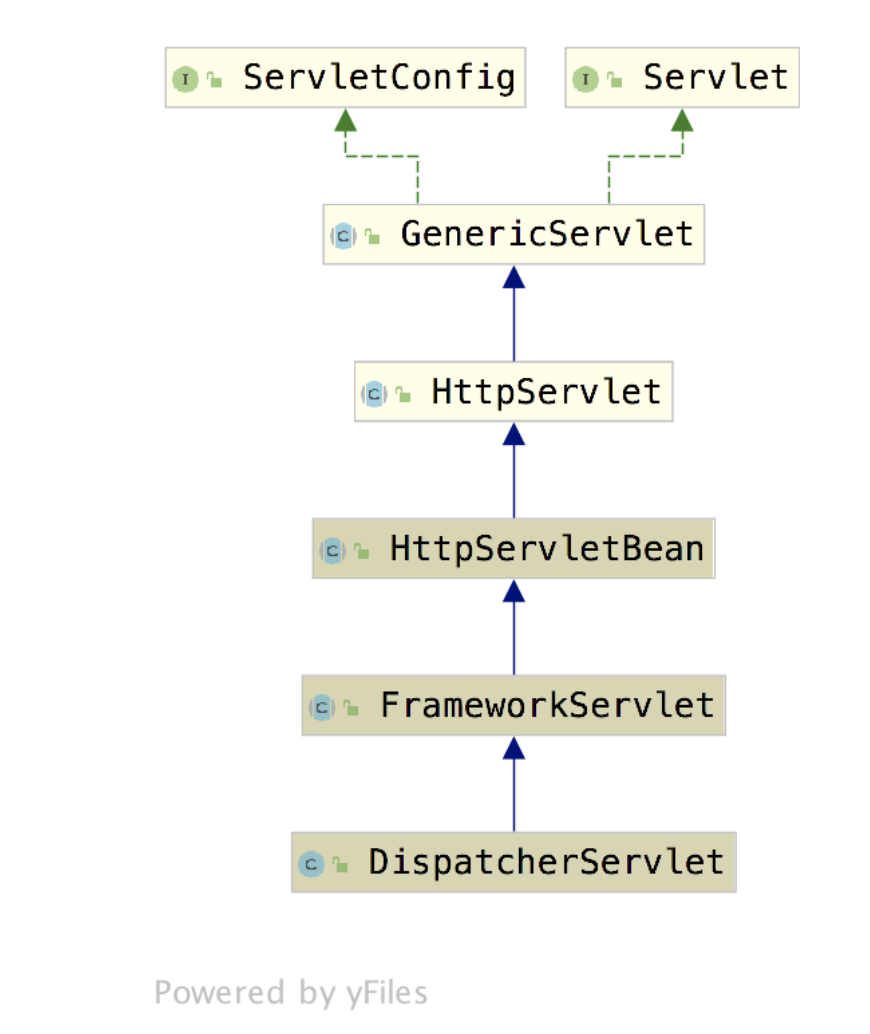
我们来到:HttpServlet#service:
可以看到这里面将ServletRequest转成HttpServletRequest, ServletResponse转成HttpServletResponse,这样就可以做更多的事情了。
@Override
public void service(ServletRequest req, ServletResponse res)
throws ServletException, IOException
{
HttpServletRequest request;
HttpServletResponse response;
if (!(req instanceof HttpServletRequest &&
res instanceof HttpServletResponse)) {
throw new ServletException("non-HTTP request or response");
}
request = (HttpServletRequest) req;
response = (HttpServletResponse) res;
service(request, response);
}
复制代码
进入到HttpServlet#service(request, response):
所有的Http请求都会经过这里,但是我们找半天没发现service实现代码在哪里,我们看到HttpServlet是一个抽象类,一般类被设计成抽象类有两个因素:
- 类中有抽象方法,需要子类实现
- 没有抽象方法,但是类不希望被实例化
那这个HttpServlet为什么要设计成抽象类呢?别急,我们看下类的注释文档:
翻译起来大概的意思就是我这个类不知道你子类是什么处理请求的,我不会帮你处理的,我这里定义好了各种请求,请你务必实现其中的某一个,不然我就给你返回错误。我们看到这里就是用了 抽象模板方法的设计模式:父类把其他的逻辑处理完,把不确定的业务逻辑抽象成一个抽象方法,交给子类去实现。
/** * * Provides an abstract class to be subclassed to create * an HTTP servlet suitable for a Web site. A subclass of * <code>HttpServlet</code> must override at least * one method, usually one of these: * * <ul> * <li> <code>doGet</code>, if the servlet supports HTTP GET requests * <li> <code>doPost</code>, for HTTP POST requests * <li> <code>doPut</code>, for HTTP PUT requests * <li> <code>doDelete</code>, for HTTP DELETE requests * <li> <code>init</code> and <code>destroy</code>, * to manage resources that are held for the life of the servlet * <li> <code>getServletInfo</code>, which the servlet uses to * provide information about itself * </ul> * / 复制代码
protected void service(HttpServletRequest req, HttpServletResponse resp)
throws ServletException, IOException
{
String method = req.getMethod();
if (method.equals(METHOD_GET)) {
long lastModified = getLastModified(req);
if (lastModified == -1) {
// servlet doesn't support if-modified-since, no reason
// to go through further expensive logic
doGet(req, resp);
} else {
long ifModifiedSince = req.getDateHeader(HEADER_IFMODSINCE);
if (ifModifiedSince < lastModified) {
// If the servlet mod time is later, call doGet()
// Round down to the nearest second for a proper compare
// A ifModifiedSince of -1 will always be less
maybeSetLastModified(resp, lastModified);
doGet(req, resp);
} else {
resp.setStatus(HttpServletResponse.SC_NOT_MODIFIED);
}
}
} else if (method.equals(METHOD_HEAD)) {
long lastModified = getLastModified(req);
maybeSetLastModified(resp, lastModified);
doHead(req, resp);
} else if (method.equals(METHOD_POST)) {
doPost(req, resp);
} else if (method.equals(METHOD_PUT)) {
doPut(req, resp);
} else if (method.equals(METHOD_DELETE)) {
doDelete(req, resp);
} else if (method.equals(METHOD_OPTIONS)) {
doOptions(req,resp);
} else if (method.equals(METHOD_TRACE)) {
doTrace(req,resp);
} else {
//
// Note that this means NO servlet supports whatever
// method was requested, anywhere on this server.
//
String errMsg = lStrings.getString("http.method_not_implemented");
Object[] errArgs = new Object[1];
errArgs[0] = method;
errMsg = MessageFormat.format(errMsg, errArgs);
resp.sendError(HttpServletResponse.SC_NOT_IMPLEMENTED, errMsg);
}
}
复制代码
我们顺藤摸瓜,找到实现HttpServlet的子类,看看哪个子类实现了service()方法,我们最终看到了DispatcherServlet实现了这个service()方法。
这里我们千呼万唤的doDispatch终于出来了,这个doDispatch做了它擅长的事情,就是 请求的分发 ,我们得慢慢品,细细品这个方法。
@Override
protected void doService(HttpServletRequest request, HttpServletResponse response) throws Exception {
//...省略掉无数代码
// 处理请求分发(做调度)
doDispatch(request, response);
}
复制代码
我们进入到:DispatcherServlet#doDispatch
我们再回顾一下SpringMVC的处理流程:
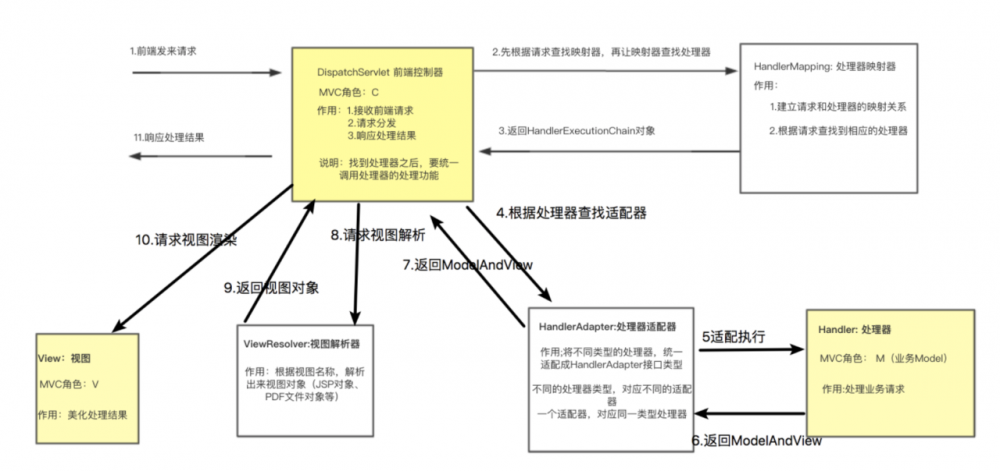
这个方法就是干这件事情的,一张图胜似千言万语。 你品,你细品
protected void doDispatch(HttpServletRequest request, HttpServletResponse response) throws Exception {
HttpServletRequest processedRequest = request;
HandlerExecutionChain mappedHandler = null;
boolean multipartRequestParsed = false;
WebAsyncManager asyncManager = WebAsyncUtils.getAsyncManager(request);
try {
ModelAndView mv = null;
Exception dispatchException = null;
try {
// 处理文件上传的request请求
processedRequest = checkMultipart(request);
multipartRequestParsed = (processedRequest != request);
// Determine handler for the current request.
// 通过处理器映射器HandlerMapping,获取handler处理器执行链,该执行链封装了处理器和对应该处理器的拦截器(可能有多个)
// 需要注意的是@Controller注解的类,它不是我们这里要查找的处理器,我们要查找的处理器是@RequestMapping对应的方法,这个方法会封装到HandlerMethod类中
mappedHandler = getHandler(processedRequest);
if (mappedHandler == null) {
noHandlerFound(processedRequest, response);
return;
}
// Determine handler adapter for the current request.
// 通过找到的handler处理器,去匹配合适的处理器适配器HandlerAdapter
HandlerAdapter ha = getHandlerAdapter(mappedHandler.getHandler());
// Process last-modified header, if supported by the handler.
String method = request.getMethod();
boolean isGet = "GET".equals(method);
if (isGet || "HEAD".equals(method)) {
long lastModified = ha.getLastModified(request, mappedHandler.getHandler());
if (new ServletWebRequest(request, response).checkNotModified(lastModified) && isGet) {
return;
}
}
// 执行拦截器(interceptor)的preHandle方法
if (!mappedHandler.applyPreHandle(processedRequest, response)) {
return;
}
// Actually invoke the handler.
// 通过处理器适配器,真正调用处理器方法
mv = ha.handle(processedRequest, response, mappedHandler.getHandler());
if (asyncManager.isConcurrentHandlingStarted()) {
return;
}
// 设置默认视图名称
applyDefaultViewName(processedRequest, mv);
// 执行拦截器(interceptor)的postHandle方法
mappedHandler.applyPostHandle(processedRequest, response, mv);
}
catch (Exception ex) {
dispatchException = ex;
}
catch (Throwable err) {
// As of 4.3, we're processing Errors thrown from handler methods as well,
// making them available for @ExceptionHandler methods and other scenarios.
dispatchException = new NestedServletException("Handler dispatch failed", err);
}
// 处理调度结果(也就是ModelAndView对象)
processDispatchResult(processedRequest, response, mappedHandler, mv, dispatchException);
}
catch (Exception ex) {
// 执行拦截器(interceptor)的afterCompletion方法
triggerAfterCompletion(processedRequest, response, mappedHandler, ex);
}
catch (Throwable err) {
// 执行拦截器(interceptor)的afterCompletion方法
triggerAfterCompletion(processedRequest, response, mappedHandler,
new NestedServletException("Handler processing failed", err));
}
finally {
if (asyncManager.isConcurrentHandlingStarted()) {
// Instead of postHandle and afterCompletion
if (mappedHandler != null) {
mappedHandler.applyAfterConcurrentHandlingStarted(processedRequest, response);
}
}
else {
// Clean up any resources used by a multipart request.
if (multipartRequestParsed) {
cleanupMultipart(processedRequest);
}
}
}
}
复制代码
SpringMVC策略模式
通过HandlerMapping找到Handler的过程
我们先来看下请求通过HandlerMapping找到Handler的过程:
我们进入到DispatcherServlet#getHandler
不出我们所料,这里就遍历了我们初始化阶段存储的handlerMappings集合,返回HandlerExecutionChain。这里使用到了策略模式:
@Nullable
protected HandlerExecutionChain getHandler(HttpServletRequest request) throws Exception {
if (this.handlerMappings != null) {
// 遍历所有的处理器映射器
for (HandlerMapping mapping : this.handlerMappings) {
// 通过处理器映射器,查找具体的处理器执行链
HandlerExecutionChain handler = mapping.getHandler(request);
if (handler != null) {
return handler;
}
}
}
return null;
}
复制代码
何为策略模式呢?我们一起来看:
我们假设有这样的需求:我们出行方式有很多种,比如火车,飞机,自行车,我们只需要输入我们有的钱就可以智能地匹配出我们的出行方式
我们来建立这样的模型:
定义一个策略类:
// 策略类
public interface TravelStrategy {
//出行方式
void travelWay();
boolean isDone(int type);
}
复制代码
定义飞机出行方式类:AirStrategy
public class AirStrategy implements TravelStrategy {
@Override
public void travelWay() {
System.out.println("坐飞机");
}
@Override
public boolean isDone(int type) {
if (type <= 1000 && type >500) {
return true;
}
return false;
}
}
复制代码
定义自行车出行方式类: BicycleStrategy
public class BicycleStrategy implements TravelStrategy {
@Override
public void travelWay() {
System.out.println("自行车");
}
@Override
public boolean isDone(int type) {
if (type <= 20) {
return true;
}
return false;
}
}
复制代码
定义火车出行方式类:TrainStrategy
public class TrainStrategy implements TravelStrategy {
@Override
public void travelWay() {
System.out.println("坐火车");
}
@Override
public boolean isDone(int type) {
if (type >= 20 && type < 400) {
return true;
}
return false;
}
}
复制代码
定义一个策略模式环境类(Context)
public class PersonContext {
// 策略类集合
private List<TravelStrategy> strategylist;
public PersonContext() {
this.strategylist = new ArrayList<>();
strategylist.add(new AirStrategy());
strategylist.add(new TrainStrategy());
strategylist.add(new BicycleStrategy());
}
public void travel(int type) {
// 输入一个数,循环遍历每个策略类,进行最优选择
for (TravelStrategy travelStrategy : strategylist) {
if (travelStrategy.isOK(type)) {
travelStrategy.travelWay();
break;
}
}
}
}
复制代码
测试类:
public class StrategyTest {
@Test
public void test() {
// 策略环境类
PersonContext person = new PersonContext();
// 坐飞机
person.travel(1500);
// 坐火车
person.travel(100);
// 自行车
person.travel(1);
}
}
复制代码
输出:
坐飞机 坐火车 自行车 复制代码
我们再来看SpringMVC中的策略模式,首先环境类DispatcherServlet, 初始化各个策略模式的是DispatcherServlet#initStrategies, 遍历策略选择最合适的策略的是:
@Nullable
protected HandlerExecutionChain getHandler(HttpServletRequest request) throws Exception {
if (this.handlerMappings != null) {
// 遍历所有的处理器映射器
for (HandlerMapping mapping : this.handlerMappings) {
// 通过处理器映射器,查找具体的处理器执行链
HandlerExecutionChain handler = mapping.getHandler(request);
if (handler != null) {
return handler;
}
}
}
return null;
}
复制代码
策略模式消除了很多的if....else...代码,通过配置文件方式定义各种策略,是一种可扩展的设计模式。
我们进入到AbstractHandlerMapping#getHandler
主要做两件事:
- 通过请求获取到处理器对象
- 通过处理器对象创建处理器执行链
public final HandlerExecutionChain getHandler(HttpServletRequest request) throws Exception {
// 调用具体的子类去获取不同类型的处理器对象(比如获取到的@Controller和@RequestMapping注解的处理器是HandlerMethod对象)
Object handler = getHandlerInternal(request);
//...省略若干代码
// 创建处理器执行链
HandlerExecutionChain executionChain = getHandlerExecutionChain(handler, request);
//...省略若干代码
return executionChain;
}
复制代码
我们来到实现类AbstractHandlerMethodMapping#getHandlerInternal
我们看到这里的handler是HandlerMethod,这个类封装了controller和Method,
@Override
protected HandlerMethod getHandlerInternal(HttpServletRequest request) throws Exception {
// 获取查找路径(部分URL)
String lookupPath = getUrlPathHelper().getLookupPathForRequest(request);
request.setAttribute(LOOKUP_PATH, lookupPath);
this.mappingRegistry.acquireReadLock();
try {
// 根据请求查找路径(部分URL),获取最合适的HandlerMethod对象
HandlerMethod handlerMethod = lookupHandlerMethod(lookupPath, request);
// 对HandlerMethod对象包含的的bean属性进行实例化,再返回HandlerMethod对象
return (handlerMethod != null ? handlerMethod.createWithResolvedBean() : null);
}
finally {
this.mappingRegistry.releaseReadLock();
}
}
复制代码
我们进入到AbstractHandlerMethodMapping#lookupHandlerMethod
这里主要做:
-
根据请求路径(URL)去上面我们分析到的urlLookup集合中获取匹配到的RequestMappingInfo集合
-
将RequestMappingInfo对象和HandlerMethod对象进行匹配,将匹配到的信息封装到Match对象,再将Match对象放入matches集合进行返回。
此时我们的处理器HandlerMethod已经找到。
protected HandlerMethod lookupHandlerMethod(String lookupPath, HttpServletRequest request) throws Exception {
List<Match> matches = new ArrayList<>();
// 根据查找路径(URL)去urlLookup集合中获取匹配到的RequestMappingInfo集合
List<T> directPathMatches = this.mappingRegistry.getMappingsByUrl(lookupPath);
if (directPathMatches != null) {
// 将RequestMappingInfo对象和HandlerMethod对象进行匹配,将匹配到的信息封装到Match对象,再将Match对象放入matches集合
addMatchingMappings(directPathMatches, matches, request);
}
if (matches.isEmpty()) {
// No choice but to go through all mappings...
addMatchingMappings(this.mappingRegistry.getMappings().keySet(), matches, request);
}
//...省略寻找最优匹配的过程代码
}
复制代码
SpringMVC适配器模式
我们再回到 DispatcherServlet#doService 方法中
找到Handler后按照我们上面的流程图,接下来就是要找到HandlerAdapter。
我们看到:
protected void doDispatch(HttpServletRequest request, HttpServletResponse response) throws Exception {
// 通过找到的handler处理器,去匹配合适的处理器适配器HandlerAdapter
HandlerAdapter ha = getHandlerAdapter(mappedHandler.getHandler());
}
复制代码
我们进入到:DispatcherServlet#getHandlerAdapter
这里无非就是根据我们初始化过程中,将配置文件中的HandlerAdapters集合进行遍历,找到合适的HandlerAdapter。
protected HandlerAdapter getHandlerAdapter(Object handler) throws ServletException {
if (this.handlerAdapters != null) {
for (HandlerAdapter adapter : this.handlerAdapters) {
// 通过适配器的适配功能,去适配处理器,如果适配成功,则直接将适配器返回
if (adapter.supports(handler)) {
return adapter;
}
}
}
throw new ServletException("No adapter for handler [" + handler +
"]: The DispatcherServlet configuration needs to include a HandlerAdapter that supports this handler");
}
复制代码
这里用到了适配器模式,我们来看看HandlerAdapter类:
public interface HandlerAdapter {
// 判断是否与当前的适配器支持,如果支持返回true,不支持返回false
boolean supports(Object handler);
// 调用handler中的请求处理方法
@Nullable
ModelAndView handle(HttpServletRequest request, HttpServletResponse response, Object handler) throws Exception;
long getLastModified(HttpServletRequest request, Object handler);
}
复制代码
SpringMVC这里为啥需要适配器呢?我们来分析一下,由于处理器handler有很多,比如Controller,HttpRequestHandler,Servlet等等,从HandlerMapping中获取到的Handler是一个Object对象,这样在DispatcherServlet#getHandlerAdapter方法中如果不用适配器模式就可能这样写:
private HandlerAdapter getHandlerAdapter(Object handler) {
if (handler instanceof HttpRequestHandler) {
return new HttpRequestHandlerAdapter();
} else if(handler instanceof Controller) {
return new Controller
}
// else if.....
return null;
}
复制代码
如果再新增一个handler就得改代码,不符合“ 对修改关闭,对扩展开放 ”的设计原则。
SpringMVC这里就给每个handler对应一个相应的适配器,比如针对Controller实现的handler对应的是SimpleControllerHandlerAdapter适配器,由SimpleControllerHandlerAdapter适配器调用Controller处理器处理相关逻辑,每个handler的处理逻辑不一样,以后再新增一个handler的时候,只用新增相应的适配器就可以了,这完美的解决了这个问题。希望读者能细品其中的设计思想。
我们继续看DispatcherServlet中的其他方法:
找到HandlerAdapter后,主要做以下几件事:
- 执行拦截器(interceptor)的preHandle方法
- 通过处理器适配器,真正调用处理器方法
- 执行拦截器(interceptor)的postHandle方法
- 处理调度结果(也就是ModelAndView对象)
- 执行拦截器(interceptor)的afterCompletion方法
SpringMVC的 拦截器 功能源码就在此步骤完成,如果读者对此感兴趣可以以此为分支进行深入研究,至此SpringMVC源码分析告一段落。
protected void doDispatch(HttpServletRequest request, HttpServletResponse response) throws Exception {
//...省略若干代码
// 通过找到的handler处理器,去匹配合适的处理器适配器HandlerAdapter
HandlerAdapter ha = getHandlerAdapter(mappedHandler.getHandler());
// 执行拦截器(interceptor)的preHandle方法
if (!mappedHandler.applyPreHandle(processedRequest, response)) {
return;
}
// Actually invoke the handler.
// 通过处理器适配器,真正调用处理器方法
mv = ha.handle(processedRequest, response, mappedHandler.getHandler());
// 设置默认视图名称
applyDefaultViewName(processedRequest, mv);
// 执行拦截器(interceptor)的postHandle方法
mappedHandler.applyPostHandle(processedRequest, response, mv);
// 处理调度结果(也就是ModelAndView对象)
processDispatchResult(processedRequest, response, mappedHandler, mv, dispatchException);
// 执行拦截器(interceptor)的afterCompletion方法
triggerAfterCompletion(processedRequest, response, mappedHandler, ex);
}
复制代码
- 本文标签: 文件上传 HTTP协议 cglib 数据 http 智能 Security web XML ORM servlet 数据库 总结 一致性 部署 时间 数据模型 解析 Action 翻译 SpringMVC AOP js equals UI src CTO message java 实例 业务层 db final 模型 description lambda 需求 ACE HTML BeanDefinition 协议 list 工作原理 https 配置 lib ArrayList CEO trigger spring Select ioc tab 开发 id Travel 适配器 代码 strace 程序员 Freemarker 服务器 value IO ip map build 回答 设计模式 IOS rmi parse bean 源码 REST 希望 tar springioc IDE 生命 App 处理器 root key 深入解析 tomcat cat schema 数据库访问 注释 文章 遍历 Service 测试
- 版权声明: 本文为互联网转载文章,出处已在文章中说明(部分除外)。如果侵权,请联系本站长删除,谢谢。
- 本文海报: 生成海报一 生成海报二











![[HBLOG]公众号](https://www.liuhaihua.cn/img/qrcode_gzh.jpg)

